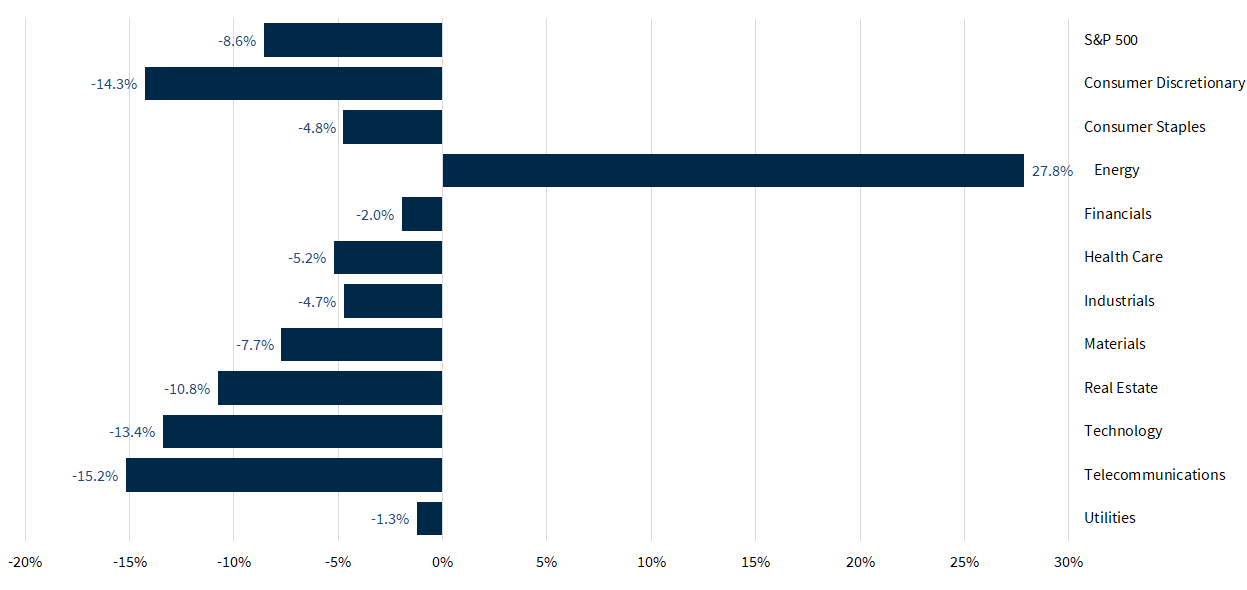The conflict in Ukraine remained at the forefront for investors. The Federal Open Market Committee (FOMC) raised rates, but the outlook for further rate hikes is more aggressive.
The FOMC raised the target range for the federal funds rate by 25 basis points (to 0.25%-0.50%) and said that it “anticipates that ongoing increases in the target range will be appropriate.” In its policy statement, the FOMC cited elevated inflation and strengthening employment. The implications of the Ukraine conflict to the U.S. economy are “highly uncertain,” according to the FOMC, but “are likely to create additional upward pressure on inflation and weigh on economic activity” in the near term. Of the 16 senior Fed officials, 12 anticipate raising rates another 150 basis points or more this year.
Retail sales rose 0.3% in the advance estimate for February, up 0.2% ex-autos – recent figures suggest seasonal adjustment issues, but the underlying trend is strong. Jobless claims fell to 214,000 (four-week average at 223,000, a very low trend). The insured unemployment rate fell to the lowest level since February 1970. February building permits and housing starts were mixed. (The 30-year mortgage rate for the latest week was 4.16%, vs. 3.22% at the start of the year.) Factory output rose 1.2% in February, despite a 3.5% decline in motor vehicle production (supply constraints).
Next week: The Russian invasion of Ukraine is expected to remain a key factor for financial market participants. The economic data releases are not critical. Durable goods orders should reflect a decrease in civilian aircraft orders (moderate otherwise). Monday at noon, Fed Chair Powell will speak to the National Association for Business Economics on the economic outlook, but he is unlikely to cover any new ground. The following week will be more eventful as fresh data on March employment and manufacturing roll in.
Indices
| Last | Last Week | YTD return % | |
|---|---|---|---|
| DJIA | 34,480.76 | 33,174.07 | -5.11% |
| NASDAQ | 13,614.78 | 13,129.96 | -12.98% |
| S&P 500 | 4,411.67 | 4,259.52 | -7.44% |
| MSCI EAFE | 2,149.67 | 2,053.78 | -7.98% |
| Russell 2000 | 2,065.02 | 2,011.67 | -8.18% |
Consumer Money Rates
| Last | 1 year ago | |
|---|---|---|
| Prime Rate | 3.50 | 3.25 |
| Fed Funds | 0.32 | 0.08 |
| 30-year mortgage | 4.5 | 3.40 |
Currencies
| Last | 1 year ago | |
|---|---|---|
| Dollars per British Pound | 1.315 | 1.397 |
| Dollars per Euro | 1.109 | 1.198 |
| Japanese Yen per Dollar | 118.570 | 108.840 |
| Canadian Dollars per Dollar | 1.261 | 1.241 |
| Mexican Peso per Dollar | 20.519 | 20.400 |
Commodities
| Last | 1 year ago | |
|---|---|---|
| Crude Oil | 103.63 | 64.60 |
| Gold | 1,941.80 | 1,729.20 |
Bond Rates
| Last | 1 month ago | |
|---|---|---|
| 2-year treasury | 1.92 | 1.45 |
| 10-year treasury | 2.18 | 1.95 |
| 10-year municipal (TEY) | 3.03 | 2.6 |
Treasury Yield Curve – 3/18/2022
 As of close of business 3/17/2022
As of close of business 3/17/2022
S&P Sector Performance (YTD) – 3/18/022
 As of close of business 3/17/2022
As of close of business 3/17/2022
Economic Calendar
| March 21 | — | Fed Chair Powell Speaks (“Economic Outlook”) |
| March 23 | — | New Home Sales (February) |
| March 24 | — | Jobless Claims (week ending March 19) |
| — | Durable Goods Orders (February) | |
| March 25 | — | Pending Home Sales Index (February) |
| — | UM Consumer Sentiment (March) | |
| March 29 | — | CB Consumer Confidence (March) |
| March 31 | — | Personal Income and Spending (February) |
| April 1 | — | Employment Report (March) |
| — | ISM Manufacturing Index (March) | |
| May 4 | — | FOMC policy decision |
All expressions of opinion reflect the judgment of the author and are subject to change. There is no assurance any of the forecasts mentioned will occur or that any trends mentioned will continue in the future. Investing involves risks including the possible loss of capital. Past performance is not a guarantee of future results. International investing is subject to additional risks such as currency fluctuations, different financial accounting standards by country, and possible political and economic risks, which may be greater in emerging markets. While interest on municipal bonds is generally exempt from federal income tax, it may be subject to the federal alternative minimum tax, and state or local taxes. In addition, certain municipal bonds (such as Build America Bonds) are issued without a federal tax exemption, which subjects the related interest income to federal income tax. Municipal bonds may be subject to capital gains taxes if sold or redeemed at a profit. Taxable Equivalent Yield (TEY) assumes a 35% tax rate.
The Dow Jones Industrial Average is an unmanaged index of 30 widely held stocks. The NASDAQ Composite Index is an unmanaged index of all common stocks listed on the NASDAQ National Stock Market. The S&P 500 is an unmanaged index of 500 widely held stocks. The MSCI EAFE (Europe, Australia, Far East) index is an unmanaged index that is generally considered representative of the international stock market. The Russell 2000 index is an unmanaged index of small cap securities which generally involve greater risks. An investment cannot be made directly in these indexes. The performance noted does not include fees or charges, which would reduce an investor’s returns. U.S. government bonds and treasury bills are guaranteed by the US government and, if held to maturity, offer a fixed rate of return and guaranteed principal value. U.S. government bonds are issued and guaranteed as to the timely payment of principal and interest by the federal government. Treasury bills are certificates reflecting short-term (less than one year) obligations of the U.S. government.
Commodities trading is generally considered speculative because of the significant potential for investment loss. Markets for commodities are likely to be volatile and there may be sharp price fluctuations even during periods when prices overall are rising. Specific sector investing can be subject to different and greater risks than more diversified investments. Gross Domestic Product (GDP) is the annual total market value of all final goods and services produced domestically by the U.S. The federal funds rate (“Fed Funds”) is the interest rate at which banks and credit unions lend reserve balances to other depository institutions overnight. The prime rate is the underlying index for most credit cards, home equity loans and lines of credit, auto loans, and personal loans. Material prepared by Raymond James for use by financial advisors. Data source: Bloomberg, as of close of business March 17, 2022.
(Eric Sams, CFP®)
(CERTIFIED FINANCIAL PLANNER ™)
(1793 E Main St // Grass Valley, CA 95945 // 530.272.5100)
(eric.sams@raymondjames.com) // (www.sams.pro)



